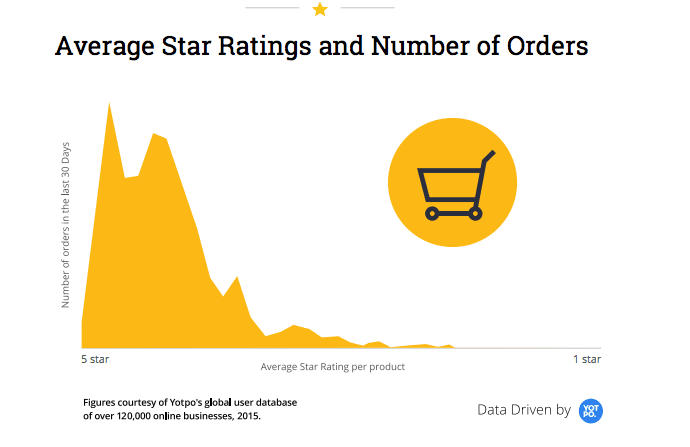what factors influenced your decision to go with a certain service provider?
If you want to become people to purchase your stuff, you lot need to empathize how consumers make purchasing decisions.
People research products. They compare competitors. Some 87% of buying decisions begin with enquiry conducted online, usually on Amazon or Google.
Product quality and seller reputation matter, of course. But what nigh when the product matches the client's needs and they trust the seller? What influences a buy decision once those fundamentals are in place?
Here are nine things yous should know if you want to win over customers as they brand a determination to purchase.
i. Reviews matter for deciding on products and companies.
Many studies in contempo years have confirmed what nosotros already know: People read reviews and decide what to purchase based on them.
Some 88% say they trust online reviews as much as personal recommendations, and 39% read reviews on a regular basis. In fact, only 12% of those surveyed don't read reviews at all. (And that was a few years agone.) We've written at length on the affect of user-generated reviews.

Then showtime gathering reviews on your site. If yous sell commodity products, you might want to pull reviews from an external site so that y'all tin can display more of them. Use structured data to get review stars from highly reviewed products into search results. Our internal written report on the impact review stars showed that they can increase click-through-rates by as much as 35%.
More reviews tin help insulate your reputation from the inevitable incommunicable-to-delight customer. That said, don't delete negative reviews. They really help sales if there are only a few of them and they're politely worded.
If there are tons of negative reviews, nearly people are naturally turned off and look elsewhere.
2. People gather buying recommendations from mixed sources.
Even though social media and the Internet dominion, customers brand purchase decisions using a combination of quondam media, new media, and conversations with friends and family. (To read more virtually this, I encourage you to check out People Comparing Shop, Stupid.)
According to a 2009 study past Harris Interactive, the most common methods for gathering information prior to making a purchase are:
- using a company website (36%);
- contiguous conversation with a salesperson or other visitor representative (22%);
- face-to-face chat with a person not associated with the visitor (21%).
Another, slightly more than recent, written report claims that 59% of people however consult friends and family unit for help with a buy determination.

Asking people around us for recommendations remains commonplace. This means the experience you provide to your customers matters a great deal.
Omnichannel journeys are on the rise besides. Customers are no longer relying on single sources. Co-ordinate to recent research, 73% of retailers say omnichannel is important to them, but simply 38% say they are beyond the kickoff stages of an omnichannel journey.
three. People don't frequently know why they like something.
In that location's a famous report nearly jam tasting. Scientists asked a big sample of consumers to rank jams on taste, ordering them from summit to bottom.
Then the scientists re-did the report with a different, only nevertheless statistically representative, group. This time, they asked the sampler to put the jams in guild of taste and explain their thinking. The order flipped. The jams that the first group ranked equally the all-time tasting were judged to as the worst by the 2nd grouping.
The reason is that the conscious brain all of a sudden got involved in a task it didn't really understand. All of a sudden, there were social pressures (i.e. what they should choose), leading answers abroad from what people actually liked.
People make instant decisions with their subconscious. When they take to explain the choice, the choice may modify completely because the rational mind is involved. (To learn more almost rational and irrational thinking, check out our articles on Organisation 1 and Arrangement 2.)
Takeaway: Don't trust people when they explicate why they bought something. They might non know themselves.
4. The crowd leads the way to buyer preferences.
About of our preferences are learned and formed by social norms and expectations.

An erstwhileWashington Post column uses the example of mollusk chowder. Decades ago, it was thin. But now, it's almost uniformly thick. What happened? At some betoken, restaurateurs got in the addiction of adding flour to make chowder thicker and thicker. At present, this is what consumers have come to consider a bowl of "authentic" clam chowder.
These learned preferences can but as easily involve characteristics that, from an objective standpoint, don't make a product any amend—and might even make them worse, especially when it comes to texture.
Ravi Dhar, a marketing professor at the Yale Schoolhouse of Management, notes that although Heinz ketchup does non reliably win in blind taste tests, it has established itself as the gold standard in its category because information technology'south thicker. In the marketing world, Dhar says, "meaningless attributes often atomic number 82 to meaningful differentiation."
Ever wondered why so many products on store shelves are and so similar? Wouldn't it exist better to make them unlike? Non necessarily.
"There are huge incentives in consumer markets, fifty-fifty for competing companies, to make everything the same, " says Dan McGinn, president of a research and strategy consultancy in Arlington, Virginia.
Yes, our preferences evolve as club evolves. That impacts our purchasing decisions. A "family motorcar" used to mean a station railroad vehicle. And so it was a minivan. At present, it's an SUV.
If you're interested in this concept, nosotros've written an article on the idea of familiarity as a marketing tactic. Essentially, the more we're exposed to something, the more than likely information technology is that we'll develop a preference for it and decide to buy information technology.
Takeaway: In markets where people have a lot of feel with the product category, information technology pays to mimic the market standard.
5. Simplicity always wins for decision-making.
Cognitive fluency is the man tendency to prefer things that are not just familiar, just also easy to understand. (That'southward why simple sites are scientifically improve.)
For marketers, this means that the easier it is to understand an offering, the more likely people are to purchase information technology.
Psychologists have determined, for example, that shares in companies with easy-to-pronounce names significantly outperform those with hard-to-pronounce names. Coincidence? Nope.
Why people dear to buy unlimited plans.
Understanding and comparing dissimilar cell-phone plans is a pain. Information technology takes time to identify the best selection. Who wants to spend 20 minutes comparing monthly minutes and text limits? And then what practice people practice? They buy the unlimited program. It'southward often not the best value, but it'southward easy to empathise.

Cell phone companies make the most money from unlimited plans, and they have an extra incentive to make other plans confusing. Plans with a fixed number of minutes charge loftier fees for going over your allotted minutes. It'due south designed to cause you lot enough pain that you lot switch to a plan with a higher regular fee.
Previous positive experiences matter.
Cerebral fluency too explains
- Why yous continue to purchase from brands and service providers yous've used before
- Why you frequently order the same matter from the menu.
It's simply easy. You've tried it, it worked, and you don't want to spend a agglomeration of time researching alternatives. You lot don't want to risk a bad buy.
As a marketer, this ways information technology'due south super important to get a client to make up one's mind on that start purchase. Pack your beginning offer with value and make information technology equally easy every bit possible to buy. One time consumers have their starting time positive buying feel, it's much easier to get repeat purchases.
Hard to read, hard to buy.
Make your website easy to read. When people read something in a hard-to-read font, they transfer that sense of difficulty onto the topic they're reading nearly.
The aforementioned goes for products and purchases. Nosotros've conducted a number of original studies on ecommerce product pages. In i of those studies, we constitute that the way products are described matters. The format of text descriptions influences how people perceive the products themselves.
Takeaway: Make every aspect of the decision to purchase as uncomplicated as possible.
vi. For retail stores, fifty-fifty flooring influences purchasing decisions.
Research by Joan Meyers-Levy suggests that the way people guess products may be influenced by the ground beneath them.
"When a person stands on carpeted flooring, information technology feels comforting," says Meyers-Levy. "Merely the irony is that when people stand on carpet, they will judge products that are close to them as less comforting."

When people were standing on soft carpeting and viewed a product that was moderately far away, they judged that item's advent to be comforting. Notwithstanding, people who examined products while standing on the same plush carpet judged items that were shut by equally less comforting.
This translates online as well. The way things are presented and emotional factors come into play. It's your responsibility to be aware of them and manage them accordingly. Seemingly unimportant details can affect consumers' determination to purchase or click away.
Takeaway: Cover walking areas in your retail shop with soft carpet, but employ difficult flooring side by side to products.
There'southward conflicting research on the influence of social media on purchase decisions. One written report found that consumers are 67% more likely to buy from brands they follow on Twitter.
Another report showed that social media rarely leads directly to online purchases. Data indicated that less than 2% of orders resulted from shoppers coming from a social network. The report found that email and search advertising were much more effective vehicles for turning browsers into buyers.
The difference between these ii studies is that the first was based on what people said, merely the 2d was based on what people really did. (Even so, they were tracking direct click-throughs from social media, non taking into account the positive influence information technology may have over time.)
The real answer is that social media probably impacts purchase decisions, just it'south a tedious, relationship-edifice procedure. Just shouting "buy this" works on a very small number of people.
Even as social media purchases go along to increment—near one-half of survey respondents in 2017 had made a purchase directly through Facebook—a full tertiary of the market had yet to purchase via social media. Less than 1 in x bought from any social channel other than Facebook.
A written report examined how the presence of a Facebook "Similar" button and the Twitter logo might affect online purchase decisions.
The findings:
- When the production was one for which public consumption is desirable (sportswear, fragrance), the presence of the Facebook and Twitter icons made people 25% more likely to purchase.
- When the product was more private in nature (Spanx, Clearasil), the presence of Facebook and Twitter icons made participants 25% less probable to purchase.
Does buying your product make your customer seem more or less absurd? Identify the Facebook and Twitter icons accordingly.
8. When it comes to buying, nosotros make emotional decisions and rational justifications.
Do people make decisions based on emotions or logic? McCombs marketing professor Raj Raghunathan and PhD educatee Szu-Chi Huang signal to their research study.
The study shows that comparative features are important but by and large as a justification for subsequently a buyer makes an emotional determination. Here's how they ran their study.
The story of two chickens
Enquiry participants were shown two photos. One was a nice-looking, plump chicken. The other was a craven that looked thin and sickly. Participants were told that the plump chicken was a natural chicken and that the sparse craven was genetically engineered.

Researchers informed one-half the participants that natural chickens were healthy (but less tasty) and genetically engineered chickens were tasty (merely less healthy). The other half were told the opposite.
Overwhelmingly, participants preferred the plump chicken, but their reasoning was dissimilar:
- The first group claimed that it was because they valued health above taste.
- The 2nd group said it was because gustation was more important.
Neither group justified their choice based on how they felt about the craven's looks. They felt compelled to justify their emotional choices with rational reasons—to the point that the ii groups gave opposing accounts to justify the same "purchase" decision.
Emotions rule in all areas of buying behavior.
The scientists replicated the results in other areas, including marketing, politics, religion, etc.
"This procedure seems to exist happening somewhat unconsciously, people are non actually enlightened they're coming up with these justifications. What is even more than interesting is that people who claim that emotions are not that important, who consider themselves to exist actually rational, are really more decumbent to fall into this trap."
What does this mean for marketers? Raghunathan suggests that the earlier you can brand an emotional connection, the better. Once consumers have decided that they similar a particular selection, information technology'southward difficult for them to backpedal. Rational thinking will only justify their emotional choice.
(You might also be interested in reading near how consumers utilize post-purchase rationalization to avoid buyer'due south remorse. The brain doesn't like to think it made an emotional determination, so we assign rational reasons for our decisions post-purchase.)
9. The subconscious drives purchase decisions.
For the terminal 50 or 60 years, marketplace inquiry, as an industry, has believed that people brand decisions based on rational, conscious thought processes. Science tells a different story, 1 that turns that fundamental conventionalities on its head. Most decision-making happens at the subconscious level.
We may focus on facts and numbers, but in many cases, it's the subliminal that makes people decide one way or another.
Conclusion
People are complex. We're just beginning to scratch the surface of what they really want. Some tests have shown that people adopt items on the right or at the bottom of the list. Why?
We don't know yet. Sometimes we make purchasing decisions fifty-fifty when nosotros aren't paying attention to the products. New questions about man thought processes and decision-making pop upwardly every day.
Neuroscience is still working on the answers, but there are some insights that we can start putting into play now.
hansonverlable1941.blogspot.com
Source: https://cxl.com/blog/9-things-to-know-about-influencing-purchasing-decisions/
0 Response to "what factors influenced your decision to go with a certain service provider?"
Post a Comment